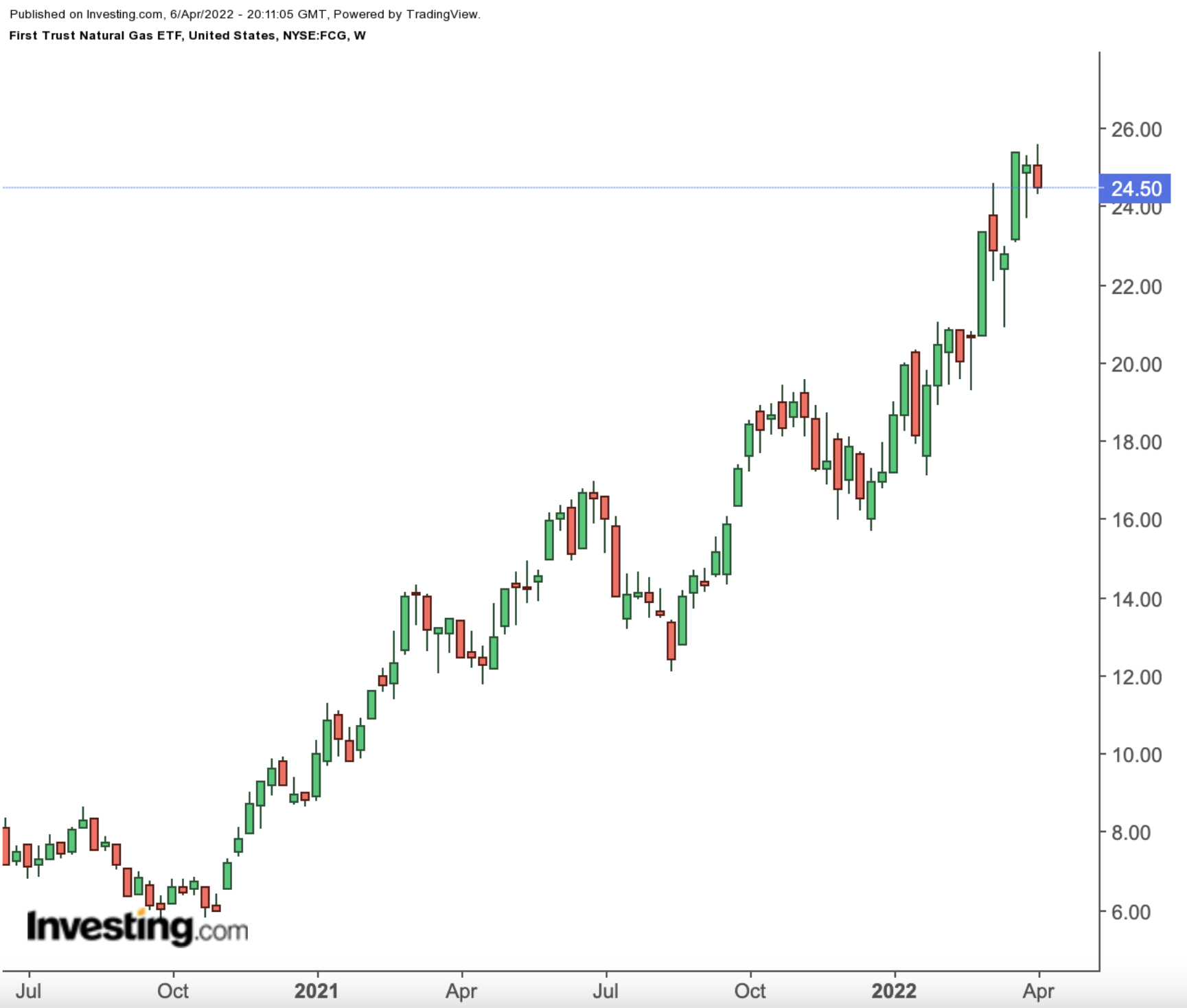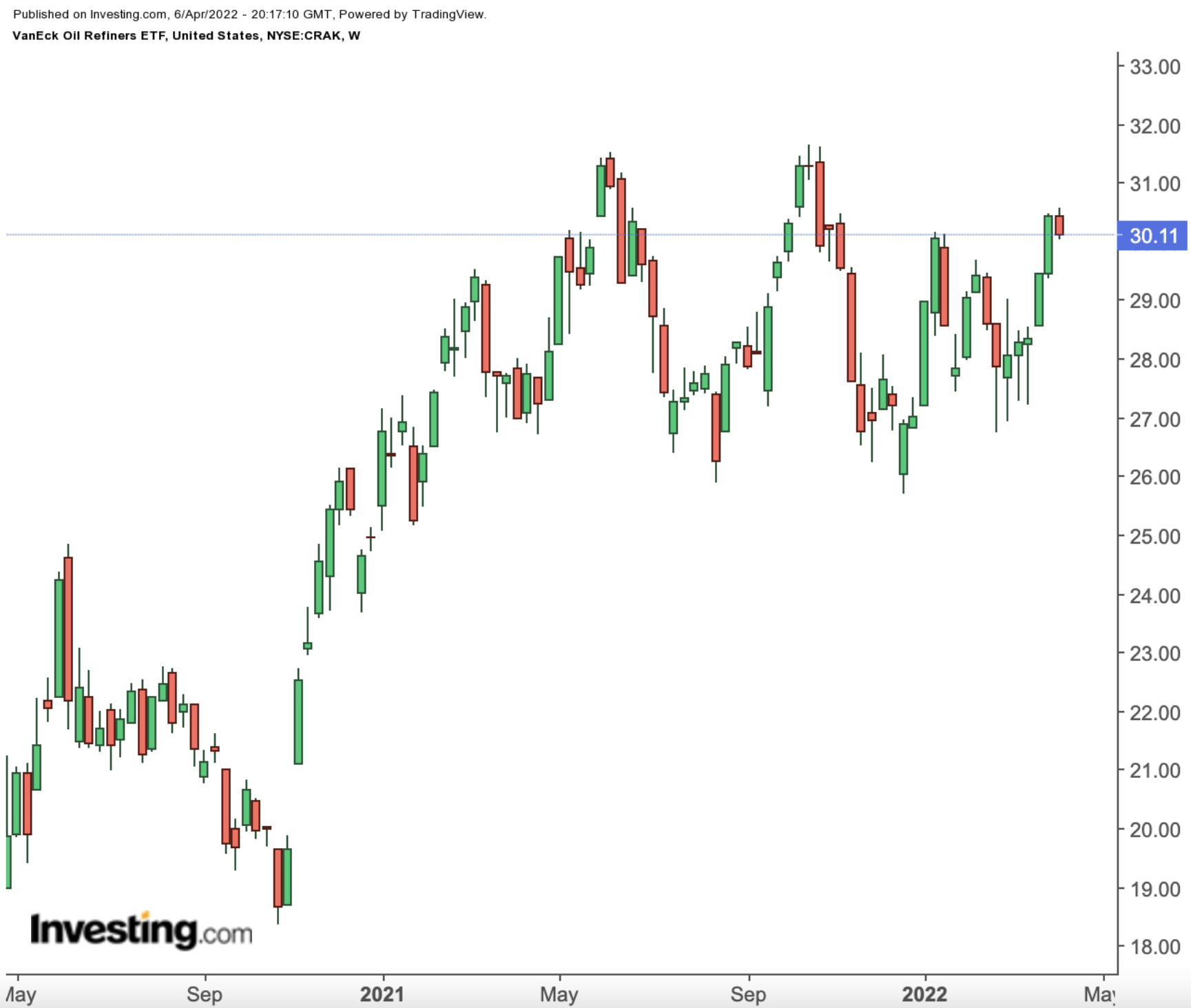After an incredible bull run at the beginning of the year, oil prices have recently declined.
As we write, Brent oil is at $103, while US West Texas Intermediate, WTI, is trading below the psychological $100 level, just shy of $98. On the other hand, natural gas prices have maintained their upward trajectory and are hovering at over $6.07.
As a result, the Dow Jones Oil & Gas Index is up over 56.6% in the 12 months and 36.4% year-to-date (YTD).

Today's article introduces three exchange-traded funds (ETFs) that could appeal to readers who are still bullish on energy stocks.
This article continues our regular discussion on energy ETFs (covered here, here, and here). While the prices of these funds are likely to stay choppy in the coming weeks, they could potentially help investors benefit from the run-up in energy prices.
1. First Trust Natural Gas ETF
- Current Price: $24.52
- 52-Week Range: $11.75 - $25.60
- Dividend Yield: 1.53%
- Expense Ratio: 0.60% per year
The First Trust Natural Gas ETF (NYSE:FCG) provides investors with exposure to explorers and producers of natural gas and oil. The fund was launched in May 2007.

FCG, which tracks the ISE-Revere Natural Gas Index, currently has 45 holdings. The top ten names on the roster comprise well over a third of net assets of $668.9 million.
Occidental Petroleum (NYSE:OXY), DCP Midstream (NYSE:DCP), ConocoPhillips (NYSE:COP), Western Midstream Partners (NYSE:WES), and EOG Resources (NYSE:EOG) are among the prominent stocks in the portfolio.
FCG, which saw a multi-year high on Apr. 5, has returned 91.4% over the past 52 weeks and 42.6% since the start of 2022.
2. John Hancock Multifactor Energy ETF
- Current Price: $31.02
- 52-week range: $17.48 - $32.36
- Dividend Yield: 1.85%
- Expense ratio: 0.40% per year
Our next fund is the John Hancock Multifactor Energy ETF (NYSE:JHME), which invests in US energy names. It started trading in March 2016.

JHME currently has 37 holdings, and its leading 10 stocks account for close to half of $32.7 million in net assets. That means that the fund is top-heavy and relatively small.
Leading holdings include Chevron (NYSE:CVX), Occidental Petroleum, ConocoPhillips, Exxon Mobil (NYSE:XOM), and Valero Energy (NYSE:VLO).
The ETF is up to 40.4% YTD and 65.2% in the past year. JHME saw a multi-year high in the final week of March.
3. VanEck Vectors Oil Refiners ETF
- Current Price: $30.05
- 52-Week Range: $25.70 - $ 31.65
- Dividend Yield: 2.14%
- Expense Ratio: 0.59% per year
Our final fund is the VanEck Oil Refiners ETF (NYSE:CRAK), which invests mainly in global crude oil refiners. The fund was first listed in August 2015 and has share prices closely tied to the difference between crude oil prices and the prices of refined products.

CRAK, which tracks the MVIS Global Oil Refiners Index, has 25 holdings. The top 10 businesses make up over 60% of net assets of $19.6 million.
Geographically, a third of the companies come from the US. Next in line are energy names from Japan (11.75%), India (7.52%), South Korea (6.39%), Poland (5.34%), Portugal (4.98%), Finland (4.81%), and others.
Marathon Petroleum (NYSE:MPC), Phillips 66 (NYSE:PSX), Indian energy heavyweight Reliance Industries (NS:RELI), Valero Energy, Japanese energy group ENEOS (OTC:JXHLY), and Finland-headquartered refiner Neste Oyj (OTC:NTOIY) are currently leading the names in the ETF.
Since January, CRAK is up 11.4%. The fund returned 8.9% in the past 12 months and saw a 52-week high in October 2021. Investors who believe global refiners will do well in the rest of the year should research CRAK further.
